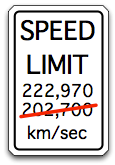A modest suggestion to increase the speed of light resulted in interesting discussion which I would like to highlight by Kit Dotson at SiliconANGLE and by Howard Marks at Network Computing. Howard Marks wrote about details of the chemistry of fiber optic cables, in particular that the index of refraction is related to the density of the material. A fiber with a 10% lower index would be less dense than water, which makes it unlikely to be practical. C'est la vie.
 Also I'll state again: the speed of light in fiber only matters for wide area links. The propagation delay in 100 meters of fiber is dwarfed by queueing and software delays, to the point of insignificance. In fact if we could reduce the cost or power consumption of short range lasers by making the speed of light even slower in the fiber they drive, that would be a good tradeoff.
Also I'll state again: the speed of light in fiber only matters for wide area links. The propagation delay in 100 meters of fiber is dwarfed by queueing and software delays, to the point of insignificance. In fact if we could reduce the cost or power consumption of short range lasers by making the speed of light even slower in the fiber they drive, that would be a good tradeoff.
For long range links things become more interesting. Internet lore says that Amazon found each 100 msec of page load time resulted in a 1% increase in abandoned transactions, though I cannot find a hard reference for this data. E-commerce is heavily studied as there is money involved, but general satisfaction with a website increases when it has "teh snappy." This isn't just a function of bandwidth: most web pages require multiple round trips to fully render, owing to the pervasive use of JavaScript to trigger the loading of additional page elements. The round trip time matters.
For long reach fiber the useable spectral capacity is probably the most important factor, as this determines the numer of wavelengths it can carry and is the primary economic justification. Long reach fibers also have to trade off clarity (i.e. loss of signal) because that determines how far apart the amplifiers/regenerators have to be. This is where I'd throw the index of refraction into the mix, as another factor to be weighed and optimized for.